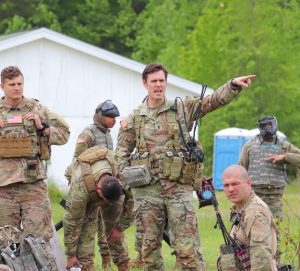Communication Tech Used in Fight Against COVID-19
[vc_row][vc_column][vc_column_text css=”.vc_custom_1592566571241{margin-top: 0px !important;margin-right: 0px !important;margin-bottom: 0px !important;margin-left: 0px !important;border-top-width: 0px !important;border-right-width: 0px !important;border-bottom-width: 0px !important;border-left-width: 0px !important;padding-top: 0px !important;padding-right: 0px !important;padding-bottom: 10px !important;padding-left: 0px !important;}”]By Sgt. James Nowell-Coleman, 29th Mobile Public Affairs Detachment
[/vc_column_text][vc_single_image image=”4451″ img_size=”large” css=”.vc_custom_1592566557514{margin: 0px !important;border-width: 0px !important;padding: 0px !important;}”][vc_column_text]The Maryland Army National Guard is borrowing some technology from the active-duty Army to fight the COVID-19 virus.
The Program Executive Office (PEO) Soldier based at Aberdeen Proving Ground, Aberdeen, Maryland, is providing a mission tracking and communications application at no cost to the Maryland Guard.
The application, called CRSSTALK, stands for Contingency Response Situational Awareness/Situational Understanding Tactical Applications Leader Kit. It allows Army leaders to view a Soldier’s current location, past location, and route of travel. From a separate location, leaders could build and communicate a mission to Soldiers on ground, while allowing a forum to upload pictures and continued correspondence. The device itself is not a military device; it is a commercial phone. First responders can also share accounts with other agencies like the National Guard.
“Mission and personnel tracking is becoming more difficult with so many moving parts, and not is the perfect time to test this new tool,” said Maj. Jesse Green, a communications staff officer in the 58th Troop Command. “CRSSTALK merges other good platforms into a mobile platform and turns every Soldier into a sensor, allowing leadership to see what is happening on the ground in real time.”
Green mentioned that Soldiers could be tracked without distracting the Soldier from their duties and without even having to make contact. Additionally, leaders can now spend more time on other critical tasks.
PEO is responsible for rapid prototyping, procurement, and fielding equipment for Soldiers. Its mission is stated to develop, acquire, field and sustain affordable integrated state of the art equipment to improve Soldier dominance in Army operations today and in the future.
This particular system is designed to be a mobile system and with the application it is possible to look at every worksite, not only Maryland but also the entire country.
Cpl. Ivan Day, an information technology specialist with the 58th Expeditionary Military Intelligence Brigade, is helping to distribute and set up CRSSTALK. Day enlisted in the Maryland Army National Guard six years ago to get experience and training in the IT field.
Day said that this has been an eye-opening experience for him.
“[As] enlisted [Soldier] you don’t get to see what the officers do on a daily basis, and as an IT specialist we are kind of in the background,” said Day. “Now, I can say, oh yeah this is how it works.”
Day said that he has the chance to not only work with senior leaders on missions, but he also gets to see the big picture on a map with actual Soldiers working missions in real time.
 1st Lt. Christofer Smith, a platoon leader with the 1st Battalion, 175th Infantry Regiment, was one of the first to use the new program.
1st Lt. Christofer Smith, a platoon leader with the 1st Battalion, 175th Infantry Regiment, was one of the first to use the new program.
Smith said the differences between the CRSSTALK system and previously used equipment is its use of a commercial cellular network. One of the CRSSTALK key features is its ability to transmit large amounts of digital information across a broad audience in real time.
“For domestic defense support to civil authorities operations, I don’t see many drawbacks,” said Smith. “I think more widespread use across the civil and military elements in the state would be beneficial on several levels.”
Smith’s unit was still working to understand and implement all the capabilities this tool has to offer, but they used the platform to display troop movements and positions, mark points of interest, communicate textually, and plot photographs. Most of the information posted in real time back to the command’s information center.
At the height of the Maryland National Guard’s support to Maryland’s response to COVID-19, more than 2,000 members were activated. The Maryland Guard works closely with the many agencies in support of civil authorities and provides unique capabilities like medical augmentation, transportation support, food distribution, and more.[/vc_column_text][/vc_column][/vc_row]
